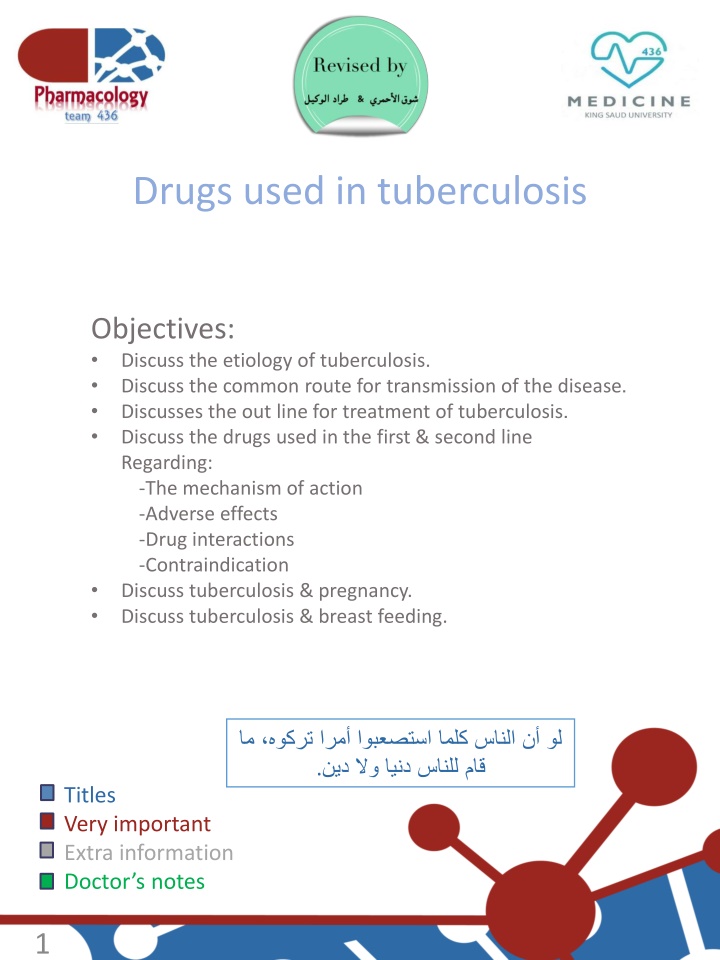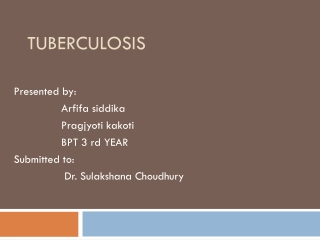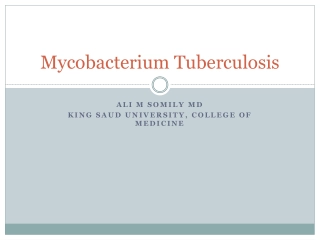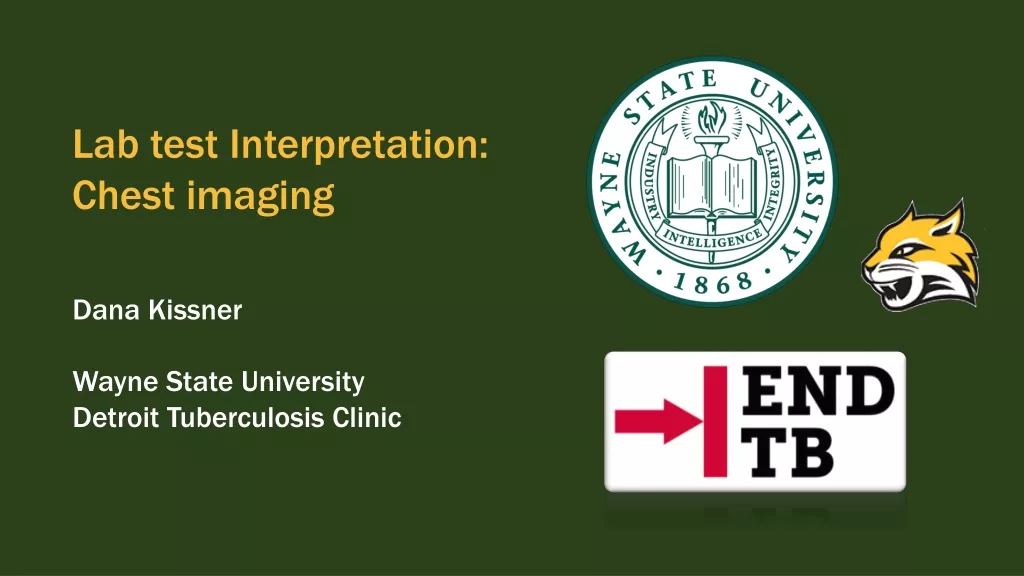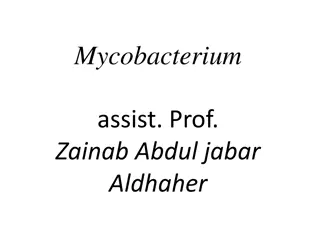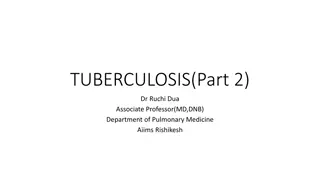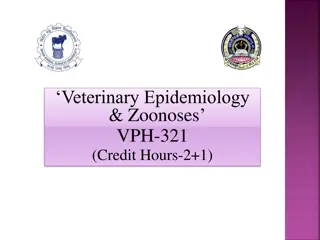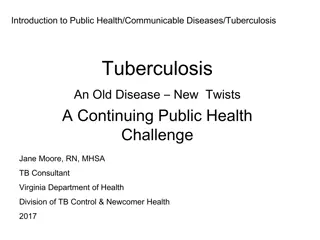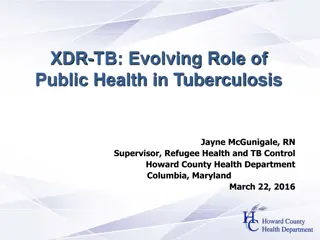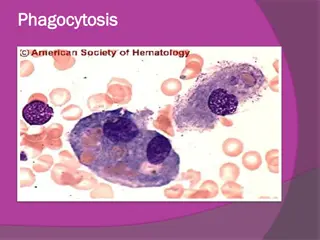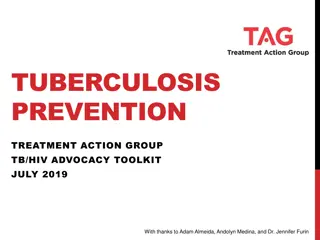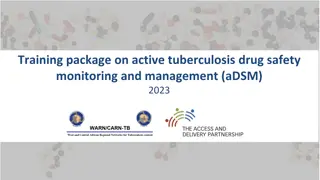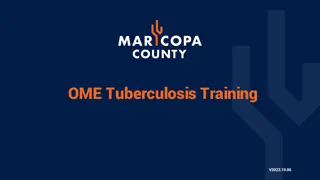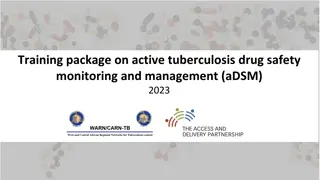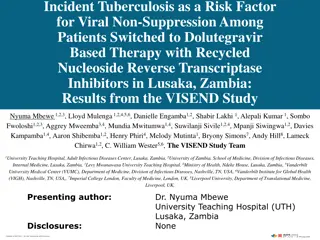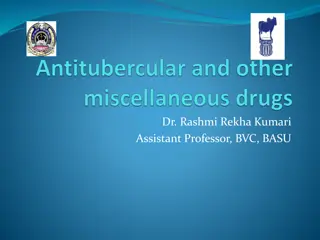Drugs used in tuberculosis
Tuberculosis is caused by Mycobacterium tuberculosis and primarily spreads through respiratory droplets. Treatment involves drug combinations to prevent resistance. First-line drugs like Isoniazid, Rifampin, Ethambutol, and Pyrazinamide are common, each with specific mechanisms, adverse effects, and interactions. Care should be taken during pregnancy and breastfeeding due to potential risks. Effective management requires adherence to treatment guidelines and monitoring for side effects.
Download Presentation

Please find below an Image/Link to download the presentation.
The content on the website is provided AS IS for your information and personal use only. It may not be sold, licensed, or shared on other websites without obtaining consent from the author.If you encounter any issues during the download, it is possible that the publisher has removed the file from their server.
You are allowed to download the files provided on this website for personal or commercial use, subject to the condition that they are used lawfully. All files are the property of their respective owners.
The content on the website is provided AS IS for your information and personal use only. It may not be sold, licensed, or shared on other websites without obtaining consent from the author.
E N D
Presentation Transcript
Drugs used in tuberculosis Objectives: Discuss the etiology of tuberculosis. Discuss the common route for transmission of the disease. Discusses the out line for treatment of tuberculosis. Discuss the drugs used in the first & second line Regarding: -The mechanism of action -Adverse effects -Drug interactions -Contraindication Discuss tuberculosis & pregnancy. Discuss tuberculosis & breast feeding. . Titles Very important Extra information Doctor s notes 1
Tuberculosis Etiology: Mycobacterium tuberculosis, slow growing, an acid fast bacillus. Robert Koch was the first to see Mycobacterium tuberculosis with his staining technique in 1882. tuberculosis incidence map Each year, 1% of the global population is infected. More than one third of the world's population has tuberculosis. Crowded, poorly ventilated houses promote growth of bacteria and chance of spreading infection. Isolation of patients is important. Individuals should not spit and should cover their mouth when coughing or sneezing. Common sites of infections Apical areas of lung. oxygen rich areas Renal parenchyma. Growing ends of bones. Treatment Of Tuberculosis Preventing development of drug resistance is the most important reason to use drug combination. Periods of treatment: ( minimum 6 months). 2
Tuberculosis according to Terms of toxicity and clinical evidence Drugs are divided into two groups: Second line First line Given for first 8 weeks, followed by INH/RIF for 18 weeks The four drugs for 2 months, then INH/RIF Isoniazid (INH) Ethionamide Fluoroquinolones (Ciprofloxacin ) Rifampin (RIF) Ethambutol Rifabutin Aminosalicylic Acid (PAS). Pyrazinamide Streptomycin should not be the 1st line choice. It should be 2nd line as it causes irreversible damage Never use a single drug therapy! Isoniazid rifampin combination administered for 9 months will cure 95-98% of cases . Addition of pyrazinamide/ethambutol for this combination for the first 2 months allows total duration to be reduced to 6 months. Use four drugs for two months then use only INH/RIF to avoid toxicity as possible this will give you 6 months of treatment instead of 9 months using INH/RIF only 3
1st Line Treatment Isoniazid Rifampin Ethambutol Pyrazinamide Streptomycin Bacteriostatic for resting bacilli. Bactericidal for rapidly growing bacilli. About Drug Bactericidal Bacteriostatic Bactericidal Inhibitor of mycobacterial arabinosyl transferase ( alters the cell barrier ) disrupts the assembly of mycobacterial cell wall. Inhibits RNA synthesis by binding to DNA dependent RNA polymerase enzyme. Inhibits the synthesis of mycobacterial cell wall (inhibit the synthesis of mycolic acid ) Inhibitors of protein synthesis by binding to 30 S ribosomal subunits. Irreversible action. Mechanism of Action Unknown Active Against Extracellular bacilli Highly polar, Given IV. Intracellular & extracellular bacilli Intracellular Bacilli -Treatment of TB - Latent TB in patients with positive tuberculin skin test -Prophylaxis against active TB in individuals who are in great risk -Mycobacterial infections mainly in multidrug resistance cases. - Important in short course (6 months) regimen. -Prophylaxis of TB . -Treatment of TB in combinatio n with other drugs. -Severe, life-threating form of T.B. as meningitis, disseminated disease. -Treatment of TB Clinical Use -Prophylaxis Enzyme inducer Clinically significant drug interactions such as warfarin, methadone will be metabolized faster Drug Enzyme inhibitor Slow and fast acetylators. Interactions - -Harmless red- orange discoloration of body secretions (saliva, sweat, tears ). Tell the patient about this effect. Can permanently stain contact lenses. -Hepatitis less common compared to INH -Flu-like syndrome -Hemolytic anemia -Peripheral neuritis (pin & needles sensation in the feet ) -Impaired visual acuity -red-green color blindness. -Optic neuritis &atrophy.(Pyridoxine should be given in both cases ) -Hepatotoxicity (common) -Ototoxicity -Nephrotoxicity ADR -Hyperuricemia ( gouty arthritis ) -Neuromuscular block very dangerous that in high doses patient might die -Hepatitis (toxic metabolites) Hepatitis with INH, is age dependent; it is rare in persons younger than 20 years , risk increases with age and alcohol use. contraindec ated in children under 5 years. -Drug fever & skin rash 4
2nd Line Treatment Fluoroquinolones (Ciprofloxacin ) Aminosalicylic Acid (PAS) Ethionamide Rifabutin - RNA inhibitor -Cross resistance1 with rifampin is complete. -Enzyme inducer (less potent than rifampin) Bacteriostatic Mechanism of action Inhibits the synthesis of mycolic acid - inhibits Folic acid synthesis. Active against Extracellular and intracellular bacilli. As a second line agent is used in the treatment of pulmonary & other forms of tuberculosis. Effective against multidrug- resistant prevention and treatment of TB & atypical TB2 As a secondary line agent ,treatment of TB. Clinical use 2nd line treatment tuberculosis - Teratogenic (interfering with the development of a fetus) - Poorly tolerated due to : Severe gastric irritation & Neurological manifestations. - GIT intolerance - Orange-red discoloration of body secretions. - GIT upset (shouldn t be used on empty stomach) -Crystalluria3 ADRs - (1) Cross-resistance is the tolerance to a usually toxic substance as a result of exposure to a similarly acting substance. (2) Atypical TB: diseases caused by non-tuberculosis mycobacteria (NTM). E.g. M. leprae causes leprosy. (3) Crystalluria: the excretion of crystals in the urine, causing irritation of the kidney. 5
Indications: 2nd line drug are more toxic than 1st line drugs, thus only used in these cases: Resistance to 1st line drugs. Contraindication to 1st line drugs. Failure of clinical response . Used in typical & atypical tuberculosis. TB & Pregnancy - Untreated TB represents a great risk to the pregnant woman & her fetus than the treatment itself. - First line (INH, Ethambutol and rifampicin) drugs are given for 9 months in normal doses. TB & Breast Feeding - It is not a contraindication to receive drugs , but caution is recommended. - Streptomycin not used. 6
SAQ1 A 34-year-old foreign-born farm worker present to your clinic complaining of dark-red urine over the past several weeks. On further history, you learn that he had a positive PPD 2 months ago. At the time, a chest X-ray indicated a lesion in the right upper lobe, consistent with tuberculosis. He was started a multidrug therapy to eradicate the infection, which he states he is currently taking. The patient s physical examination is completely within normal limits. You reassure the patient that the urine discoloration is a harmless side effect of his medication, and you order a serum and urine studies to ensure that there is no indication of damage to liver or kidney. Q1: Which anti-mycobacterial agent is the patient currently taking? Rifampin Q2: What is the mechanism of action of this drug? Inhibits RNA synthesis by binding to DNA dependent RNA polymerase enzyme. Q3: Describe the Drug-Drug interaction mechanism of this drugs. This drug is an enzyme inhibitor which then will prolong the duration of action of any drug that is metabolized by enzymes as warfarin. Q4: What other side effect could we see in this patient. This drug causes discoloration of most of the body secretions including: Sweating. Tears. Urine. And saliva. This drug also could cause nephritis and hepatitis. Hemolytic anemia. Flu like syndrome. 7
SAQ2 A 14-year-old foreign-born Hispanic women arrives at your pediatric clinic for an annual physical examination. She immigrated to the kingdom 2 years ago and she lives with her parents, younger brother, and maternal grandmother. Of note, the grandmother was just hospitalized 2 days ago for fever, chills, and cough with sputum that demonstrates acid-fast bacilli bacteria. The patient s parents note that the patient s PPD has been positive in the past due to BCG vaccination as an infant. She report no concerning symptoms and her physical examination is unremarkable. Nevertheless, given the grandmother's history, you decided to place the child on a prophylactic pharmacologic regimen to prevent active TB and you suggest that her brother and parents also consider prophylactic medication as well. Q1: What is the drug of choice in this prophylactic therapy? Isoniazid Q2: What is the mechanism of action of this drug. It has bactericidal and bacteriostatic effects which is caused by Inhibition of the synthesis of mycobacterial cell wall (mycolic acid) Q3: List the major side effect of this drug. Peripheral neuropathy due to vitamin B6 deficiency. Hepatitis. G6PD- deficient hemolytic anemia. Q4: Describe the Drug-Drug interaction mechanism of this drugs. This drug is an enzyme inhibitor which then will decrease the duration of action of the drugs that is metabolized by the enzymes such as warfarin. 8
QUIZ Boys Girls Contact us : @Pharma436 Pharma436@outlook.com 9
